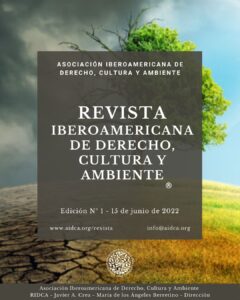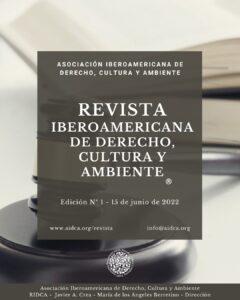ISSN 2953-3554
Recommendations to authors
The Ibero-American Journal of Law, Culture and Environment is a publication that covers various topics from different areas of knowledge, Legal-Academic.
It assumes four categories of scientific work:
a) Scientific research article
b) Review article
c) Reflection articles or essays
d) Case studies
Submitted papers must be original and unpublished and must not have been presented or published in another journal. Receive articles in Spanish, English and Portuguese.
The Ibero-American Journal of Law, Culture and Environment is not responsible for the opinions and statements expressed in the articles, these are the sole responsibility of the authors.
Article submission deadline
The Ibero-American Journal of Law, Culture and Environment will receive articles for its second edition until December 15, 2022. They should be sent to the email address: info@aidca.org
Article
The contents published in the Ibero-American Journal of Law, Culture and Environment are registered and protected by the laws for the protection of intellectual property. When submitting the manuscript, and only if it is accepted for publication, the copyright of the published articles belongs to the authors.
The names and email addresses entered in this magazine will be used exclusively for the purposes stated in it and will not be provided to third parties or used for other purposes.
The papers must be sent in Microsoft Word format and with no length limit. It is suggested, but not exclusive, that the articles be written in Calibri typography; score 12; single line spacing with automatic leading and trailing; Letter size 21.59 cm x 27.94 cm (equivalent to 8 1/2 x 11 inches); and margins of 2.5 cm on each side and that citations and bibliographical references are made according to the APA Standard Seventh Edition (2019).
Suggested format. Not exclusive
Title
It will appear in Spanish, Italian, English or Portuguese; It must be explicit and precise, it must not exceed 15 words, reflecting its content unequivocally. No formulas, abbreviations or acronyms may be used.
Abstract
It is written in a precise and concise language, in the past tense; where the objectives, methodology used, most relevant results and main conclusions of the investigation are included. It is written in a single paragraph in Spanish, English and Portuguese; with a maximum length of 200 words.
Keywords
Between three and eight words or groups of words arranged alphabetically, separated by commas. They will appear in Spanish, English or Portuguese. They must be related to the content of the work for better inclusion in national and international indexes and databases. You can rely on the UNESCO thesaurus for your selection.
http://vocabularies.unesco.org/browser/thesaurus/en/groups.
Text of the articles
Among the wording must be clear and concise, All the acronyms cited must have their meaning.
In the case of scientific research articles and case studies, the following structure is recommended, not being exclusive:
Introduction
– It is written in the present, with a descriptive-narrative style.
– Refers to the purpose of the work, its scope and importance, as well as current knowledge
about the topic; citing the most relevant contributions on the subject.
– Includes the theoretical and rational foundation of the study: the what and why of the investigation.
– The main (general) and secondary (specific) objectives must be made explicit.
– The hypothesis or research question and the scientific problem are declared.
– Provide only strictly pertinent references and conclusions of the
reported scientific result.
– There should not be an excess of bibliographic citations, since for a detailed study on the subject they are
review articles.
– For more information on the introduction according to the APA standard 7th edition, consult the link: https://normas-apa.org/estructura/introduccion/
Materials and methods
– It is written in the past (measured, studied, analyzed, checked, etc.), with a descriptive style.
– The criteria used to choose the object of study and the steps followed appear.
– Clearly expresses all relevant protocols, methods and characteristics of the materials
employed to arrive at the results.
– Presents the materials evaluated (technical specifications, quantities, origin or method
of preparation, generic or chemical names, avoiding commercial ones).
– A complete description of the methods used should appear so that the reader can
evaluate the suitability of the methods, the reliability and the validity of their results, facilitating
that another researcher can replicate the methodology and compare the results.
– The size of the sample must be declared; Statistical analysis should be done using
specialized software.
– You must present the period of time and scenarios studied, as well as comment on the main
research limitations.
– The use of acronyms, measurement systems, etc. is declared, if required.
Results
– They are written in the past tense with a descriptive-narrative style, clearly and concisely, without excessive use
of verbs.
– They must summarize the information collected and the analysis carried out on the most relevant data
through text, tables and figures (only up to 8 tables).
– The tables and figures must be self-explanatory, so that the reader does not have to go to the
text to understand the information presented.
– Numerical results must be provided, not only derivatives (for example, %) but also
the absolute numbers from which the derivatives were calculated and must be specified
the statistical methods used.
– The international system of units will be used.
– The correct statistical expressions will be used and redundancies will be avoided.
– They express themselves without making value judgments or drawing conclusions.
Discussion
– It is written in the present, but in the past when the results obtained are discussed.
– What is really important is considered, emphasizing the new and essential aspects of the
study, its importance, implications and limitations.
– Data or other material provided in the Introduction section should not be repeated in detail.
or Results.
– For experimental studies, it is useful to begin the discussion by summarizing the main
findings, then explain possible mechanisms or explanations for these findings.
– Compare and contrast how the research is different from what is reported
above and how the authors’ observations will significantly advance the
current knowledge of the subject.
– Unqualified statements and criteria not supported by data should be avoided.
– Possible applications of the results obtained are discussed.
– It must be based on statistical analysis and contributions from other authors with similar studies, more not on subjective appraisals.
– Recommendations and suggestions for future research may appear.
– It should not be compared with too many studies, as it can distract or confuse the reader.
– Abbreviations should be kept to a minimum and defined on first use in the text.
In some cases, a common section is made: Results and discussion, in which at the same time
that the results are presented and are discussed, commented or compared with other studies;
in other cases the results and discussion can be separate sections.
Conclusions
– They are written in an impersonal way, using a language referring to what is exposed in the topic.
– Brief summary of the content of the article, with the most important contributions and
possible applications, avoiding lexical decorations and expressing them as directly
possible.
– They will be governed by what is proposed in the introduction.
– It is not about contributing new ideas, but rather compiling what is indicated in the results and
discussion.
– No citations from another author should appear.
– There must be correspondence with the stated objectives.
– They should not appear numbered, or with bullets.
Footnotes
All articles must be prepared with notes at the end of the document (do not use footnotes), only to expand information and include definitions.
The font will be Times New Roman, 10 points.
They must be numbered with Arabic numerals and must not exceed 40 words, otherwise
these should be incorporated into the general text.
Citations and bibliographical references
Citations and bibliographical references will follow the style of the American Psychological Association.
(APA), 7th edition of 2019.
The veracity of the citations and bibliographical references will be the exclusive responsibility of the author or
authors of the article.
Only the page number will be included in direct citations.
Only the works cited in the text should appear, in alphabetical order with indentation
French.
For more information on citations and bibliographical references consult the link:
https://normasapa.org/introduccion/citas-vs-referencias-vs-bibliografia/
Acknowledgments: this is optional and should not exceed 100 words. External technical (person, institution, or organization) and financial (grants, projects, and scholarships) help should be acknowledged; as well as collaborations; that should be acknowledged but do not justify co-authorship.
Sending
Original papers should be sent to the email address info@aidca.org.
Those that are sent to the personal email addresses of the members of the editorial team will not be considered as such, and the authors will not be entitled to any claim.
Although it is not exclusive, we suggest that the works be sent in Microsoft Word format, written in Calibri typography; score 12; single line spacing with automatic leading and trailing; Letter size 21.59 cm x 27.94 cm (equivalent to 8 1/2 x 11 inches); and margins of 2.5 cm on each side. The citations and bibliographical references we suggest are made according to the APA Standard Seventh Edition (2019).
The figures that will appear in the articles will be numbered in a separate compressed file. You must also send a copy in PDF format with the figures inserted in the corresponding place.
The file must have the name of the author’s surname followed by a hyphen and the title of the article.
APA Format
APA style provides a foundation for effective scholarly communication because it helps authors present their ideas in a clear, concise, and organized manner. Uniformity and consistency allow readers to (a) focus on the ideas being presented rather than the format, and (b) quickly scan key points, findings, and sources. Style guidelines encourage authors to fully disclose essential information and allow readers to dispense with minor distractions such as inconsistencies or omissions in punctuation, capitalization, reference citations, and presentation of statistics.





